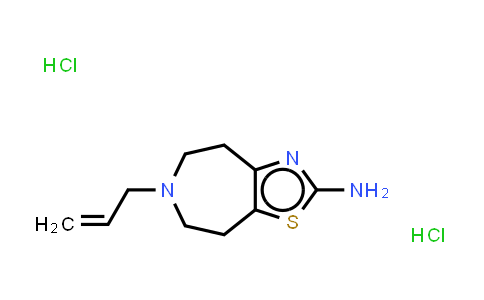
Talipexole NLT 98%
Product Number : MC501997
CAS Number : 101626-70-4
Molecular Formula : C10H17Cl2N3S | Molecular Weight : 282.23
Synonyms : B-HT 920
Quote Request| Purity | NLT 98% |
|---|---|
| Storage | at 20ºC 2 years |
| MolCore specializes in manufacturing high-purity CAS No.101626-70-4, Talipexole with the molecular formula C10H17Cl2N3S and molecular weight 282.23 delivering critical API intermediates for global pharmaceutical and research industries, certified under ISO quality systems. | |
* The above information is for reference only.
| Chemical Name | Talipexole |
|---|---|
| CAS Number | 101626-70-4 |
| MDL Number | MFCD00274573 |
| Molecular Formula | C10H17Cl2N3S |
| Molecular Weight | 282.23 |
| Synonyms | B-HT 920 |
Talipexole (B-HT920) is a dopamine agonist that has been proposed as an antiparkinsonian agent. Target: Dopamine Receptor B-HT920 is a selective alpha 2-adrenoceptor agonist. The effects of B-HT920 have been specified using the alpha-adrenergic antagonists yohimbine and prazosin and the dopamine antagonist haloperidol. Yohimbine could not antagonize any of the actions of B-HT920. Pretreatment with prazosin showed a decrease in the loss of body weight caused by B-HT920, while pretreatment with yohimbine showed that B-HT920 induced an increased loss in body weight. These data suggest that B-HT920 under certain conditions exerts dopamine-agonistic actions in stimulating locomotor activity and alpha 1-adrenergic actions in inducing salivation and enhanced loss of body weight [1]. Concomitant treatment with talipexole, an anti-parkinsonian drug, inhibited MPTP-induced autolysis and individual death in a concentration-dependent manner. Pramipexole showed a similar protective effect. In addition, post-treatment with talipexole at 1 hr after MPTP completely inhibited MPTP-induced individual death. Although MPTP treatment caused 30% of the planarians to undergo autolysis and individual death within 12 hr, post-treatment with talipexole even at 12 hr completely rescued the remaining 70% of the planarians from death. These results suggest that the MPTP-treated planarian may be useful as a novel parkinsonian model in which talipexole has a protective effect even in the case of post-treatment [2].
© Copyright 2015-2025 Hangzhou MolCore BioPharmatech Co.,Ltd. All rights reserved.
